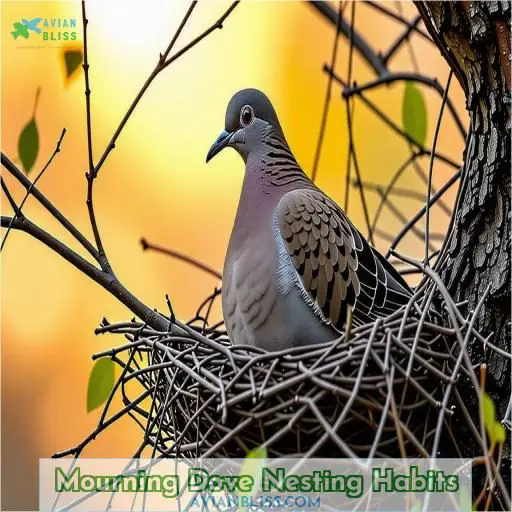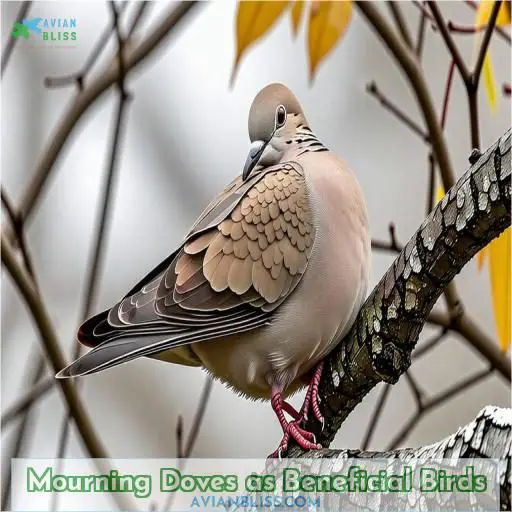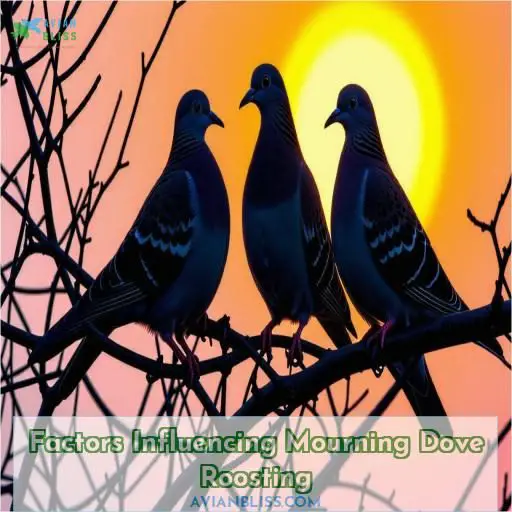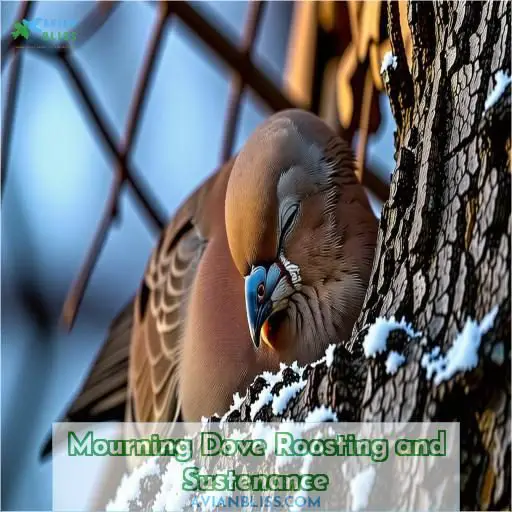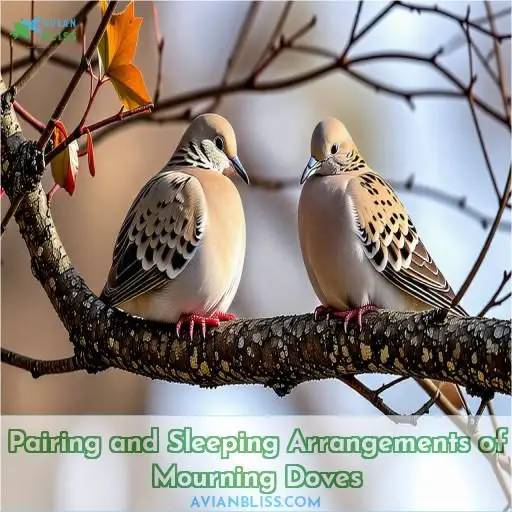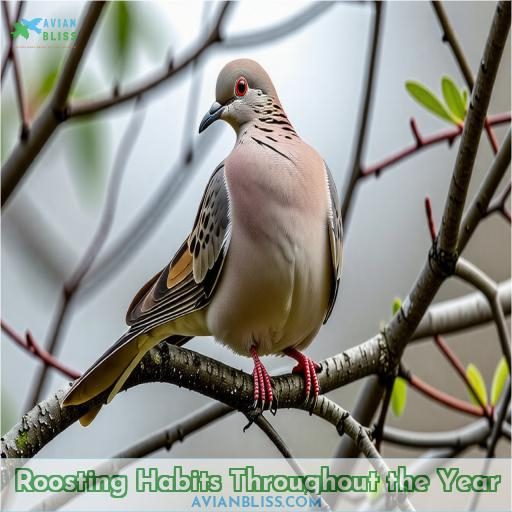This site is supported by our readers. We may earn a commission, at no cost to you, if you purchase through links.
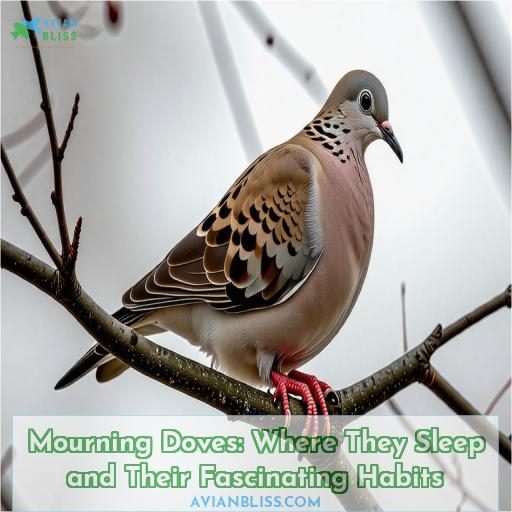
The size of these roosting flocks can vary, with birds pairing up for the breeding season but sleeping together in larger groups the rest of the year. Mourning doves are adaptable and may even roost on man-made structures.
Knowing where these birds sleep sheds light on their fascinating nighttime habits and the importance of habitat selection.
Keep reading to discover more about mourning doves’ daily lives and how they thrive in diverse environments.
Table Of Contents
- Key Takeaways
- Mourning Dove Nesting Habits
- Where Do Mourning Doves Sleep at Night?
- The Reproduction Season of Mourning Doves
- Mourning Doves as Beneficial Birds
- Roosting Behavior of Mourning Doves
- Factors Influencing Mourning Dove Roosting
- Mourning Doves’ Perception of Humans
- Mourning Dove Roosting and Sustenance
- Pairing and Sleeping Arrangements of Mourning Doves
- Roosting Habits Throughout the Year
- Frequently Asked Questions (FAQs)
- Where do mourning doves nest at night?
- What month do mourning doves lay eggs?
- Are mourning doves good to have around?
- Do mourning doves recognize humans?
- Do mourning doves sleep in the same place every night?
- How do mourning doves choose their roosting spots?
- Do mourning doves sleep alone or in groups?
- What time of night do mourning doves typically go to sleep?
- Do mourning doves sleep in the same place year-round?
- Conclusion
Key Takeaways
- Mourning doves sleep in flocks at night, roosting together in dense trees, shrubs, and even on man-made structures like power lines for safety and warmth.
- The size of these roosting flocks can vary, with birds pairing up for the breeding season but sleeping together in larger groups the rest of the year.
- Mourning doves prefer deciduous and coniferous trees for roosting, often choosing spots near reliable food sources.
- Habitat selection is vital for mourning doves, as they seek locations that offer protection from predators and harsh weather conditions.
Mourning Dove Nesting Habits
Mourning doves are fascinating in their nesting habits, showing remarkable behaviors essential for their survival. The construction of their nests involves the use of twigs, grass, and sometimes pine needles, with the female making the final adjustments.
Nest site selection is vital, often found in trees, shrubs, or man-made structures such as building ledges. The typical nest is positioned about 5-25 feet above the ground, providing a safe space for the nestlings.
Mourning doves are vigilant in the defense of their nests, often engaging in distraction displays or alarm calls to deter potential threats .
Where Do Mourning Doves Sleep at Night?
Mourning doves sleep in flocks at night, often roosting in dense trees or shrubs for safety and warmth. They prefer deciduous and coniferous trees, but also use man-made structures like power lines.
Doves typically roost near reliable food sources. The size of the roosting flock varies, with some containing hundreds of birds. Mourning doves spend around 12 hours per night sleeping, with the duration influenced by factors like moonlight and weather.
They sleep with their heads tucked between their shoulders. Doves are known for their distinctive cooing calls, which can be heard from roosting sites at dawn and dusk.
The Reproduction Season of Mourning Doves
Mourning doves typically begin their breeding season in February, with egg-laying continuing through October. The frequency of breeding is closely tied to food availability, with more abundant resources allowing for multiple broods per season .
Month of Mourning Dove Egg Laying
Avoid discussing things which would be discussed in the NEXT SUBTOPIC entitled ‘Mourning Doves as Beneficial Birds‘.
Breeding Frequency and Food Availability
During the reproduction season, Mourning Doves‘ breeding frequency is influenced by food availability. They primarily feed on seed sources including weed seeds, corn, and sunflower seeds. Consuming up to 20% of their body weight daily, they stockpile food in their crop. Understanding their foraging patterns and nutritional needs is essential for supporting successful breeding cycles.
Mourning Doves as Beneficial Birds
Mourning doves play a beneficial role in the ecosystem by consuming weed seeds and waste grains, which can help control plant growth and reduce crop damage. Their adaptability to urban and agricultural areas allows them to coexist with humans while providing these ecological services.
Ecological Role
Mourning doves play a crucial role in seed dispersal, their feathers provide nesting material for other birds, and their lifespan of 1-2 years supports the ecosystem’s balance. Their wings enable flight at 55 mph, and they sleep with their heads tucked between their shoulders.
Agricultural Impact
Mourning doves help disperse seeds, but their prolific breeding can lead to crop damage. Hunting regulations and conservation efforts aim to balance their ecological role with agricultural needs.
Coexistence With Humans
Mourning doves show increased tolerance to human interactions, often found in urban habitats. Conservation measures are essential due to declining population trends. Understanding mourning dove mating behavioral patterns coexisting with house sparrows and red-winged blackbirds is imperative.
Roosting Behavior of Mourning Doves
Mourning doves are social birds that roost together in flocks, especially outside the breeding season. They prefer roosting in dense deciduous and coniferous trees, woodlots, and thick vegetation. Doves may also roost on manmade structures like power lines.
Flock size varies, with larger groups forming in winter. Roosting preferences can change seasonally, with doves seeking warmer, more sheltered spots in colder months. Habitat selection is critical, as doves choose locations that offer protection from predators.
Mourning doves, descendants of the extinct passenger pigeon, have adapted well to human environments, often roosting near food sources. Their social roosting behavior likely evolved to enhance survival and reproduction.
Factors Influencing Mourning Dove Roosting
Mourning doves roost in a variety of locations, from dense trees to manmade structures like power lines. The specific roosting site is influenced by factors like food availability, time of year, and the presence of a mate .
Common Roosting Locations
Mourning doves prefer roosting in dense deciduous and coniferous trees near reliable food sources. They often gather in large flocks in areas with ample sustenance, such as agricultural fields and backyard feeders. The size of the roosting group depends on food availability in the surrounding habitat.
Roosting Habits Beyond Mating Season
Mourning doves roost communally in dense trees outside breeding season, with roost size fluctuating. Factors like food availability, weather, and predation risk influence roost site selection. Doves typically arrive at dusk and depart at dawn, with roosting behavior varying by location and time of year (Source).
Mourning Doves’ Perception of Humans
Mourning doves have adapted remarkably well to human presence, often thriving in urban and suburban areas. These gentle birds perceive humans as non-threatening, allowing them to nest and roost in close proximity to homes and businesses. Mourning doves exhibit three key behaviors that demonstrate their comfort around people:
- Nesting on human-made structures like ledges, gutters, and potted plants
- Feeding on spilled birdseed and cracked corn provided by backyard enthusiasts
- Perching calmly on power lines and trees, even when humans are nearby
This adaptability has contributed to the mourning dove’s success as a species, as they’ve been able to exploit the resources and habitat created by human urbanization. Their calm demeanor and willingness to coexist with people make them a welcome sight in many neighborhoods.
Mourning Dove Roosting and Sustenance
Mourning doves have different roosting habits during and outside of the breeding season. During mating, pairs roost together, while outside of breeding, they gather in large flocks to sleep in trees, shrubs, and even on manmade structures like power lines .
For Breeding Season
During mating season, mourning doves pair up and roost together. The male brings twigs for the female to weave into a flimsy nest. Both parents incubate the eggs and feed the young pigeon milk until they fledge. Seasonal roosting facilitates courtship and reproduction.
Outside Breeding Season
When not breeding, mourning doves roost communally in dense trees, often near reliable food sources. Their seasonal population shifts impact urban areas. Climate change may alter roosting habits. Doves disperse seeds and interact with other birds. Roosting outside mating season differs from breeding period.
Pairing and Sleeping Arrangements of Mourning Doves
Mourning doves pair up for the breeding season, sticking together as a couple until their young have fledged. During this time, they sleep side-by-side, often cuddling on their nest or a nearby branch.
Pair bonding is strengthened through mutual preening and cooing duets. The male defends his mate and nest site, chasing off rivals. Females choose mates based on their courtship displays and nest-building skills.
Both parents share incubation duties, with the male sitting on the eggs during the day and the female taking over at night. The male collects nesting materials like twigs and pine needles, passing them to his mate to weave into their flimsy platform nest.
Roosting Habits Throughout the Year
The roosting habits of mourning doves exhibit intriguing seasonal variations .
Communal roosting in dense deciduous trees and conifers is a prominent behavior observed throughout the year, serving as a means of protection and socialization for the doves .
Additionally, mourning doves exhibit roosting preferences in diverse locations, including dead trees, farming sites, and areas with convenient access to food .
These preferences are influenced by the presence of reliable sustenance sources, reflecting the close association between roosting behavior and the availability of food .
Understanding the nuances of seasonal roosting and communal roosting provides valuable insights into the behavioral patterns of mourning doves .
Frequently Asked Questions (FAQs)
Where do mourning doves nest at night?
At night, mourning doves typically roost in dense foliage of trees or shrubs, often in large flocks. They may also nest on man-made structures like gutters or eaves .
What month do mourning doves lay eggs?
Mourning doves typically lay their eggs from February to October, with peak breeding season occurring from April to July . They may raise up to six broods in a single season, with each clutch containing two eggs .
Are mourning doves good to have around?
Mourning doves are beneficial in urban areas as they consume pests and weed seeds, contributing to natural pest control and weed management. Their calming call also enhances the natural ambiance, providing a pleasant atmosphere for urban residents.
Do mourning doves recognize humans?
Mourning doves are quite tolerant of human presence near their nests. They’ll often stay put even when approached closely, as their instinct is to protect their eggs and young .
Do mourning doves sleep in the same place every night?
Mourning doves often sleep in the same place every night, particularly during their reproductive season. They typically roost in deciduous and coniferous trees or manmade structures like power lines, preferring locations near reliable food sources.
How do mourning doves choose their roosting spots?
Mourning doves choose roosting spots based on safety, warmth, and proximity to food sources. They often roost communally in dense evergreen trees, avoiding predators and harsh weather. Abandoned buildings and power lines also make suitable roosts in a pinch.
Do mourning doves sleep alone or in groups?
Mourning doves sleep in flocks during the non-breeding season, roosting communally in dense trees or shrubs for warmth and protection . Pairs sleep together while nesting, with the male and female taking turns incubating their eggs (Source).
What time of night do mourning doves typically go to sleep?
Mourning doves typically settle in for the night around dusk, roosting together in dense trees or shrubs for protection from predators and the elements . They’ll awaken at first light to begin their day .
Do mourning doves sleep in the same place year-round?
Mourning doves sleep in the same roosting spots year-round, typically dense evergreen trees or shrubs that provide shelter from weather and predators . They may roost closer to buildings in winter for added warmth (Source).
Conclusion
Ultimately, the sleeping habits of mourning doves are a proof of their adaptability and resilience. By roosting together in dense foliage or even on man-made structures, these birds thrive in diverse environments.
Understanding where mourning doves sleep sheds light on their fascinating nighttime behaviors and the importance of habitat selection for their survival. As you observe these birds, take a moment to appreciate their ability to flourish in the face of changing landscapes.

